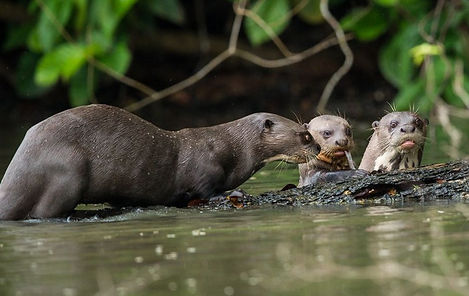

Giant River Otters- Scientific name (Pteronura brasiliensis) are very good hunters they are also known as the “River Wolf”
Giant River Otters are born completely covered in fur. They even have fur on their noses. They can grow to be 70 lbs and 6 feet long. This is about the size of a large dog. They are members of the South American Mustelidae (weasel) family. They are born in underground dens and only learn to swim after a few months. They are very social and are not afraid of humans. They are carnivores and very successful predators as they are so fast and large.
Look at their incredible flippers.
Their fur is known for being incredibly soft with a chocolaty brown color. They spend about half their day grooming themselves to keep their coat clean, as they do not have a thick layer of fat like many water mammals. Their fur is what keeps them warm. Giant Otter numbers decreased quite a bit by the 1970’s as their pelts were in high demand.
Family Groups
Groups of Giant Otters are called “Rafts”. Though Giant River Otters are monogamous so they pair up with another otter for life. They are not very successful at reproduction. Females give birth to 1-6 pups at a time and the male does not help with the little ones. They live in groups anywhere between 2 to 20 members. They are known for working very well together with occasional acts of aggression towards other members.
Food
Giant River Otters are carnivores. That means they only eat meat. For otters this means primarily fish. They eat Black Piranha which are dangerous themselves.
This fish has been found to have the strongest bite for it's size of any creature that has ever existed.
Environment
They are found in low land tropical rain forests of Northern South America. They are now becoming rare. They live only in the creeks and rivers of the La Plata, Amazon and Orinoco river systems. They have cave systems that they live in on land so they are not always in the water.
Reason for Endangerment
They were hunted for their pelts and are now facing habitat loss and other threats, the Giant River Otter was moved from "vulnerable" to "endangered" on the International Union for Conservation and Nature’s Red List between 1996 and 2000.
Because of the way they move towards threats they can be vulnerable to humans and other predators.
Language
Giant River Otter's noises or vocalizations have been studied quite a bit. They speak to each other with sounds that communicate the most complex language of any of the otter species. Adults have 22 types of sounds. This shows how long and important their relationships with each other are.


Giant River Otter
Black Piranha- Giant River Otter Food
Watch the Video and Hear the Giant River Otter's talk to each other.
Click on Waves and Print out a GIANT RIVER OTTER trading Card
Photo Credits Arniworks
Photo Credits Arniworks
References:
World Wide Fund for Nature http://wwf.panda.org/about_our_earth/teacher_resources/best_place_species/
current_top_10/giant_otter.cfm
National Geographic http://news.nationalgeographic.com/news/2013/10/131023-giant-river-otter-animals-science-reddit/
http://www.nationalgeographic.com/animals/mammals/g/giant-otter/
Public Library of Science- PLOS One http://journals.plos.org/plosone/article?id=10.1371/journal.pone.0112562
